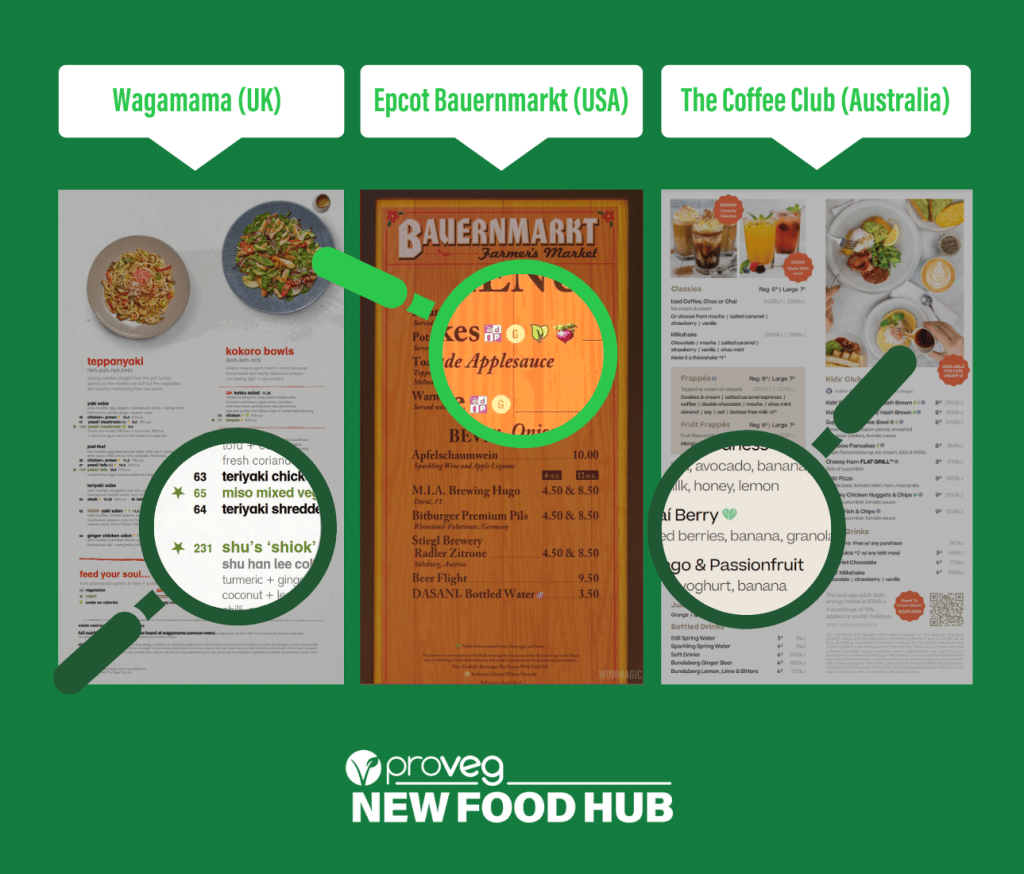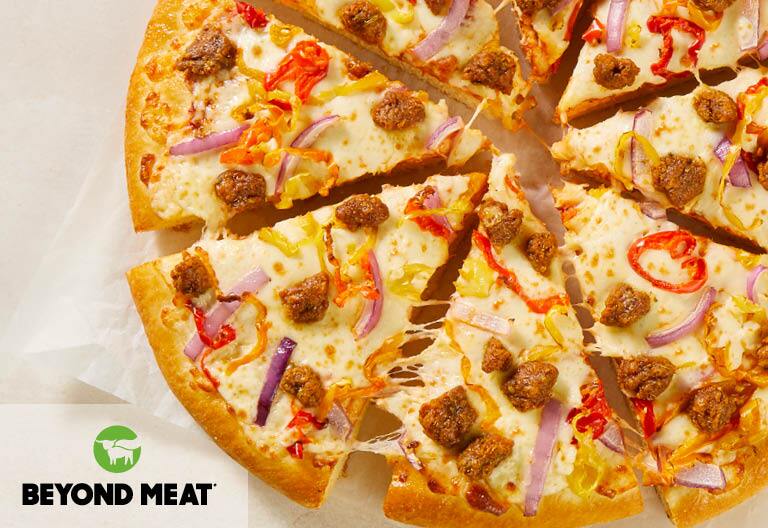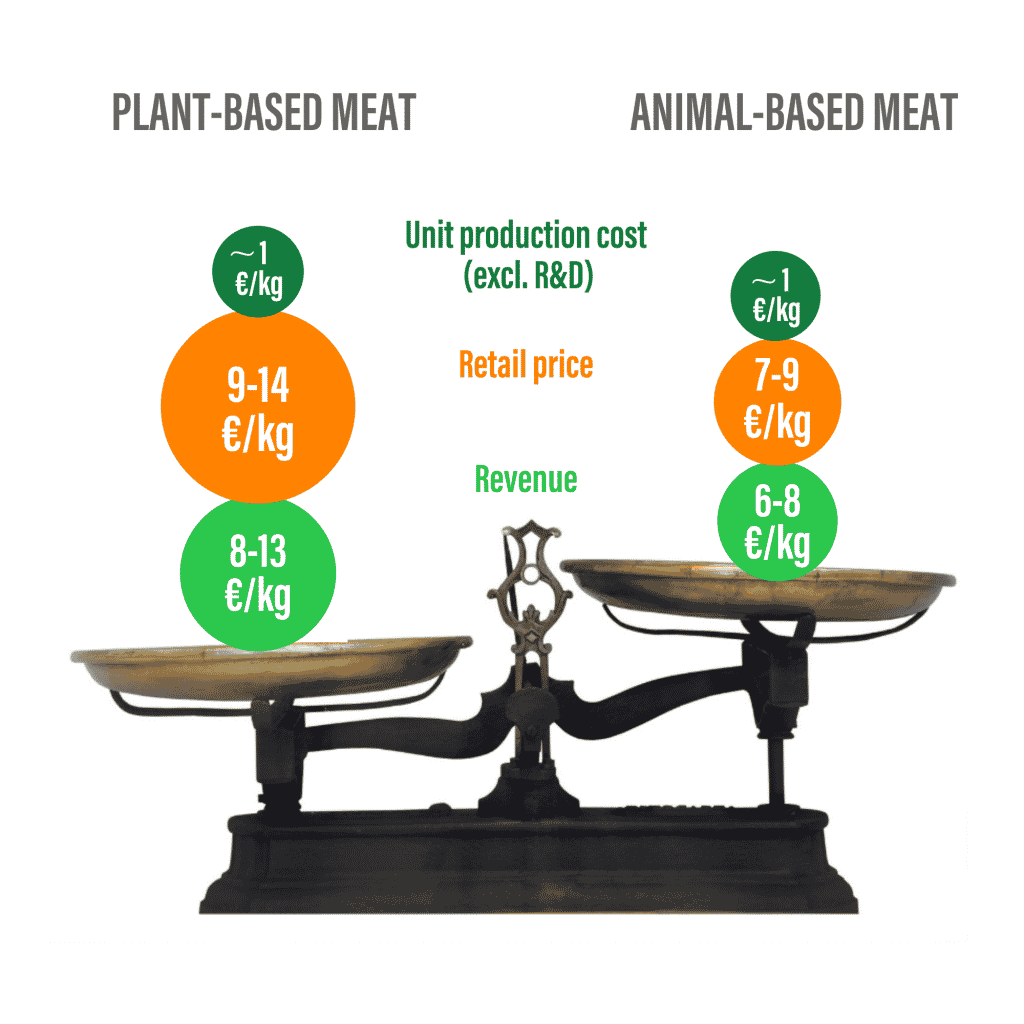Executive Summary
Food services can use proven techniques from behavioural economics to nudge consumers towards more sustainable, plant-rich menu options, while maintaining your bottom line.
- Ensure plant-based alternatives are integrated into your menu alongside conventional items – segregating them suppresses sales, but making them prominent increases flexitarian purchases.
- If you have items on display, make sure that the plant-based alternatives are next to the conventional versions – and are ideally the same price.
- Be among the market leaders who are already achieving 50% plant-based menus in order to achieve their sustainability goals and cater to the burgeoning number of flexitarian consumers.
- Think about adding to your menu – consumers don’t want to feel they’re missing out; they want delicious, protein-rich alternatives to the dishes that they know and love.
- Make single-menu items (e.g. soup of the day) plant-based by default.
- Focus on creating protein-rich, plant-based versions of your country’s ‘power dishes’ (i.e. the top 25 dishes familiar to all consumers) in order to maximise appeal among a broad consumer base.
- Emphasise the taste and sensory benefits, provenance, traditional identities, and protein content of your plant-based dishes (e.g. instead of a ‘meat-free sausage’, call it a ‘classic spiced Berlin veggie currywurst’).
- Use small symbols on your menu to indicate dishes that are vegan or vegetarian, and consider replacing conventional ‘V’ or ‘Ve’ labels with PB (for plant-based) or unobtrusive symbols such as a leaf.
- Consider introducing your own plant-based symbol like a green bicep emoji in order to promote the high-protein content of your plant-based dishes.
- For dishes that will continue to contain animal-based ingredients, replace some of them with plant-based alternatives (for example, swapping out some beef for lentils). 1 Research has shown that this does not negatively impact on diner satisfaction.2
- Make sure that chefs are trained in the possibilities of plant-based foods.
- Ask plant-based brands if they offer chef training for using their products – many do.
- Make sure that your serving staff are 100% clear on the difference between vegan, vegetarian, and flexitarian diets, so that they can give quick and informed answers and recommendations to consumers.
- Implement price parity between your conventional and plant-based dishes.
- Partner with brands or wholesalers to achieve economies of scale for newer plant-based proteins like burger patties, sausages, and cheeses, and pass on these price savings to consumers.
- Cap any price premium at 5-10%3, otherwise you’ll lose the 30-50% of consumers who are price-sensitive flexitarians and be left with the 5-10% who are vegan or vegetarian.4
- Don’t cut costs by replacing animal-protein with low-protein vegetables. Rather, ensure that your plant-based alternatives have comparable protein content, otherwise consumers will think that they’re missing out and will avoid the dish.5
- Make sure to choose high-quality and delicious items (rather than category killers) – if you’re unsure which plant-based alternatives will be a hit with mainstream consumers, ProVeg is on hand to provide expert advice
Introduction
Food-service businesses need to embrace sustainable catering menus in order to meet their net-zero targets and keep pace with the rising consumer demand for plant-based alternatives, with at least 30% of European consumers reducing their animal-based meat and dairy consumption.6
In order to achieve this, food-service organisations need to proactively normalise the consumption of plant-based alternatives. Why? Because studies have shown that “people’s assessment of how desirable food is increases when exposed to peers’ positive opinions about that food”.7 A 2017 study found that using phrases like “more and more people are choosing to eat plant-based diets” successfully nudged canteen consumers towards meat-free options.8

Burger King’s flagship London restaurant went 100% plant-based for four weeks during March-April 2022. The ultimate nudge for flexitarians – and great publicity for the company.
Collectively, the research shows that consumers are highly receptive to social proof, and can be successfully nudged towards sustainable options, but that the food-service organisation must be proactive in creating a choice-architecture environment that is conducive to these decisions.
However, consumers are habit-driven, meaning that there’s an inherent obstacle to them adopting new eating habits, even if the desire is there in the first place. In this article, you’ll learn how choice architecture and nudge principles are being used to increase flexitarian purchases of plant-based meals across the Global North. Find out who’s doing what, and how it’s benefiting their canteens and restaurants so that your business can keep pace with modern consumer demands.
Definitions
Here are three quick definitions of the behavioural-psychology principles we reference in this article. The concepts were created by Nobel-Prize-winning behavioural psychologist Richard Thaler and Harvard professor Cass Sunstein in 2008, and have been used by governments and organisations around the world ever since.
Choice architecture is “the practice of influencing choice by ‘organising the context in which people make decisions”.9
Nudge principles are a subset of this, being “any aspect of the choice architecture that alters people’s behaviour in a predictable way without forbidding any options or significantly changing their economic incentives. To count as a mere nudge, the intervention must be easy and cheap to avoid. Nudges are not mandates. Putting the fruit at eye level counts as a nudge. Banning junk food does not.” 10
Social proof is a related, earlier concept explaining how humans often make decisions when they’re unsure about something. “Informational influence occurs in ambiguous situations where we are uncertain about how to behave and look to others for information or cues. Social proof is an informational influence (or descriptive norm) and can lead to herd behaviour.” 11
In this article, we’ll be looking at how choice architecture and nudges can help food-service businesses to sell more plant-based alternatives to the burgeoning flexitarian consumer segment.
Now that we’re clear on the terminology, let’s find out how food-service professionals are leveraging these principles in order to drive sustainable menu sales.
Integrate menu placements
Segregating plant-based menu items suppresses mainstream sales. One study found that putting vegetarian items in separate areas or boxes on a menu can reduce ordering rates by 56%.12 European café chain Pret A Manger similarly found that sales of veggie products were lower when placed in ‘veggie only’ refrigerators compared to integrating them with mainstream products.13
In a previous article, ProVeg spoke to the Behavioural Insights Team, who are experts in change management (they were formerly the “Nudge Unit” in the British government, before becoming an international consultancy). They believe that choice architecture is vital when it comes to menus, saying that the “segregation of vegetarian items on menus and in shops is detrimental for multiple reasons”:
- Segregation reinforces the perception that plant-based meals are different, which mixed eaters interpret as meaning ‘not for me’.
- Segregation makes it harder for flexitarian consumers to make the plant-based choices they would want to, because those options aren’t available in the places where they’re used to looking.
- Consumers often find choice overwhelming, so they tend to adopt “rapid and simple choice-elimination strategies” with menus. A segregated menu area for vegan or vegetarian meals subconsciously invites flexitarians to ignore these items, because they will often disregard an entire menu section in order to make choosing easier.14
Given that, in food retail, up to 90% of plant-based alternatives are purchased by flexitarians, and that up to 55% of consumers in the Global North now identify as flexitarian, the opportunity for plant-based revenue is huge. To serve mainstream consumers’ increasing desires for animal-free products, and to meet your net-zero targets, try integrating plant-based options alongside other menu items. Putting them at the top of each section has also been shown to increase sales to mainstream consumers.15 “If we put delicious plant-based choices at the top of the menu, not buried somewhere, that culture shift will happen,” agrees David Mulcahy, Food Innovation and Sustainability Director at Sodexo (UK & Ireland).
Case Study: Greggs integrated placement
Greggs is a British bakery chain with over 2,000 stores across the country16 that made headlines by introducing a vegan version of its popular pork sausage roll. The alternative product is made with a Quorn filling, and has a higher protein content than its pork counterpart.17 Greggs positions the vegan sausage rolls alongside the pork sausage rolls on its baked counter, making the alternative product prominent and appealing to flexitarian consumers.
The results? Within the first seven weeks of being introduced in 2019, the new product increased company-wide revenues by 14%. By the six-month mark, the integrated vegan product had driven a 58% increase in revenue, compared to the previous year.1819

Greggs’ vegan sausage rolls achieved such mainstream popularity that the company launched them in supermarkets in 2021.
Greggs successfully increased their flexitarian sales of plant-based alternatives by:
- creating an analogue of a product with which consumers are familiar;
- making it the same price as the conventional product;
- placing it prominently on the same bakery shelves as the conventional version.
Developing and launching a plant-based product that becomes a runaway hit like the Greggs sausage roll requires the perfect mix of preparation, innovation, hard work, and promotion. ProVeg can help you to succeed with the entire process of launching a revamped plant-based menu that your consumers will love. To get started, reach out to us at [email protected].
Action for food-service professionals:
- Ensure that plant-based alternatives are integrated into your menu alongside conventional items – segregating them suppresses sales, while making them prominent increases flexitarian purchases.
- If you have items on display, make sure that the plant-based alternatives are next to the conventional versions – and are ideally the same price.
Visibility and availability
As the menu and positioning examples above show, visibility is key to driving flexitarian purchases of plant-based alternatives. Another important way to boost visibility is by increasing the number of plant-based dishes on your menu.
A 2019 Cambridge University study of 100,000 canteen meals found that adding an extra vegetarian option reduces meat consumption without reducing overall sales.20 In other words, people are open to great alternatives if you provide them.
Behavioural economists support this view too, as Dr Filippo Bianchi, Senior Advisor at the Behavioural Insights Health Team, explained in an interview with ProVeg. “There is promising evidence that increasing the availability of healthy and sustainable foods could help people make more sustainable choices,” he says. “The best way to support flexitarians with reducing their meat intake is probably through interventions that make it easy to turn intentions into action.”

Increasing the visibility and availability of plant-based alternatives is key to supporting consumers in making sustainable choices.
A number of restaurant brands are taking steps in this direction. International food-services provider Sodexo is aiming to make at least 30% of its menu plant-based by 2025. “We’re trying to do it so that people feel you’re giving them options, not taking them away,” explains David Mulcahy, Food Innovation and Sustainability Director at Sodexo (UK & Ireland).
In 2021, the international Japanese restaurant chain Wagamama announced that it was making 50% of its menu plant-based, and launched its newly balanced menu later the same year.21 The company’s website states that this is part of their sustainability strategy to lower their emissions and reduce their environmental impact. The Restaurant Group, which owns Wagamama and other international chains, reported a dramatic increase in orders of vegan items across its businesses — from 5% to 20% between 2021 and 2022.22
In 2021, Berlin University also stepped up its plant-based offering in response to student demands for more sustainable options. The menus across 34 canteens are now 68% vegan and 28% vegetarian, with one meat-based meal being served four times a week.23
Actions for food-service professionals:
- Be among the market leaders who are already instituting 50% plant-based menus in order to achieve their sustainability goals and cater to the burgeoning flexitarian segment.
- Think about adding to your menu – consumers don’t want to feel they’re missing out, they want delicious, protein-rich alternatives to the dishes they know and love.
- Make daily specials (e.g. soup of the day) vegan by default.
Aim for mainstream consumers when marketing plant-based alternatives
How you present plant-based alternatives to consumers massively influences the appeal of these dishes. Labels such as ‘vegan’ and ‘vegetarian’ have negative connotations in some countries, and are off-putting to flexitarian consumers who may associate these terms with broader lifestyle commitments or malnourishment. Research by the Good Food Institute found that variants of the label ‘plant-based’ increased mainstream consumer purchasing intent by around 20% compared to the label ‘vegan’.24 (For more detailed insights on terminology, check out our dedicated article on which terms to use when.)
Multiple studies have found that mainstream consumers are most enticed by:2526
- taste and sensory appeal
- familiarity and tradition
- high protein content
Male consumers, in particular, face social barriers when considering plant-based alternatives. A 2018 international survey of adult men by Vegconomist found that the majority (54%) of vegan men have experienced or witnessed social ostracisation on the basis of food preferences.27 The study also found that these participants wanted to see athletes endorsing plant-based alternatives in order to counteract negative stereotypes. Fortunately, these role models are becoming increasingly present.

“I’ve never had any drawback!” says rugby league champion and vegan campaigner Anthony Mullally, when discussing his plant-based diet.28
The Behavioural Insights Team (BIT) found that plant-based alternatives need a ‘masculinity makeover’ in order to overcome negative attitudes.29 This was addressed head-on by the Netflix documentary The Gamechangers, which showcased the benefits of vegan diets. The film, which features endorsements from famous plant-based athletes such as Arnold Schwarzenegger, Dotsie Bausch, Lewis Hamilton, and Morgan Mitchell, has been viewed by millions of people worldwide…
So how can food retailers overcome cultural barriers and make their plant-based alternatives more appealing to mainstream consumers? In order to satisfy and entice consumers, ProVeg recommends that food-service businesses:
- Focus on creating plant-based versions of their country’s ‘power dishes’ (i.e. the top 25 dishes familiar to all consumers). BIT research shows that this will change core buying habits and reinforce the normalisation of plant-rich diets.30
- Design your meals to be rich in plant-proteins by replacing like with like (e.g. don’t replace a beef burger with a mushroom burger, use a high-protein, plant-based patty)
- Highlight the protein content – this is a key benefit that consumers want to know about.
- Emphasise national or traditional identities.
For example, instead of describing a plant-based menu item as a “cheese-free, vegan pepper- and-aubergine lasagne with salad”, you should say something like “rich and creamy Italian-style lasagne bursting with flavour and 100% plant-based protein”.
British retailer Sainsbury’s discovered the power of this back in 2017. They found that renaming their “Meat-Free Sausage and Mash” to “Cumberland-Spiced Veggie Sausage & Mash” increased canteen sales of the dish by 76%.31
Actions for food-service professionals:
- Focus on creating protein-rich, plant-based versions of your country’s ‘power dishes’ (i.e. the top 25 dishes familiar to all consumers) in order to maximise appeal and normalise plant-based eating.
- Emphasise the taste and sensory benefits, provenance, tradition, and protein content of your plant-based dishes (e.g. instead of a “meat-free sausage” call it a “classic spiced veggie currywurst”).
Use small dietary symbols
Dietary symbols are important for consumers who are seeking a guarantee that a product is vegan or vegetarian. However, these consumers typically make up less than 10% of the total market, compared to the 30-50% of consumers who identify as flexitarian.32
For the latter group, dietary symbols can be off-putting. A 2019 meta-analysis by the World Resources Institute found that for most consumers ‘vegan’ means ‘different from me’, and ‘vegetarian’ means ‘healthy but unsatisfying food’.33 In the US, mainstream consumers see those two labels as lifestyle choices rather than as mainstream foods.34

Some food-service market leaders are sidestepping potentially negative connotations by using new symbols and labels to make their plant-based menu items more appealing to mainstream consumers.
In recent years, food-service companies have begun experimenting with alternatives. For instance, replacing ‘V’ or ‘Ve’ with ‘PB’, a leaf, or other symbols,35 the logic being that vegans will always figure out what these symbols mean, whereas mainstream consumers will gloss over them and focus on the item description without being put off by the category.
Actions for food professionals:
- Use small symbols on your menu to indicate dishes that are vegan or vegetarian, and consider replacing conventional ‘V’ or ‘Ve’ labels with ‘PB’ (for plant-based) or unobtrusive symbols such as a leaf.
- Consider introducing your own plant-based symbol such as a green bicep emoji to promote the high-protein content of your plant-based dishes.
Reduce meat content in dishes
When it comes to the remaining animal-meat items on your menu, you can make them more sustainable by replacing some of the animal-based protein they contain with plant-based alternatives. As one senior ingredient researcher at a global food manufacturer told us, their business is reducing animal-based ingredients such as milk, by 50%. “The downside is that the products won’t become vegan, but it is easier, from a food-technology perspective, to achieve the same quality and taste by reducing animal-product content” – while enabling them to reduce their environmental impact.
UK retailer Sainsbury’s has an extensive ready-meal range as well as in-store restaurants and is optimising its recipes in order to reduce its food-related emissions. The company is encouraging consumers to join them on this plant-based journey through their campaign ‘try your halfest’ (a pun on ‘try your hardest’ that makes the challenge less daunting for flexitarians). Sainbury’s is helping consumers to eat more sustainably by cutting the animal-based protein of their ready meals in half. As their promotional video explains, “chickpeas will meet chicken, lentils will meet lamb, beans will meet beef!”.36 This progress and other initiatives have enabled Sainsbury’s to bring its net-zero target forwards by five years to 2035, and keep pace with modern consumer preferences for lower-meat diets.37

The Sainsbury’s Try your halfest’ campaign video has been viewed over three million times on YouTube.
Similarly, international restaurant chain Pizza Hut has been experimenting with plant-based meat alternatives as part of its 2030 net-zero target.38 In some countries, the Beyond Meat Italian sausage is offered as a plant-based topping on dairy-cheese pizzas, while in other countries they offer a soya-based chicken alternative.3940 The chain is clearly targeting mainstream consumers since these toppings aren’t restricted to their vegan menu items. Instead, they’re using a stepping-stone approach in order to make formerly animal-meat dishes vegetarian rather than going fully vegan in a single leap.

In January 2022, Pizza Hut Canada launched Beyond Meat toppings on its dairy-based dishes at 450 restaurants nationwide.
ProVeg has been working with school canteens across the UK in order to help schools serve more sustainable, plant-rich meals. Catering Leeds, which provides meals for 200 schools across the city of Leeds, serving 33,000 meals per day, wanted to reduce its food-related emissions.
ProVeg began supporting Catering Leeds in 2018. We reviewed their school menus and gave advice on language, positioning, and meaningful choices. We introduced the catering teams to delicious new recipes and trained the chefs in preparing these plant-rich options. As a result of the collaboration, Catering Leeds has successfully introduced a meat-free day a week, and swapped over three-million meals from animal-based to plant-based. Catering Leedswas further able to reduce its emissions by replacing 50% of the red-meat content in minced dishes with lentils.

ProVeg provides ongoing support to Catering Leeds and other organisations across the UK, helping them to develop plant-rich menus and optimise their successes. Is your food-services team ready to benefit from our expertise? If so, please reach out to us at [email protected].
Action for food-service professionals:
- For dishes that will continue to contain animal-based ingredients, replace some of these ingredients with plant-based alternatives (for example, swap out some beef for lentils).41 Research has shown that this does not negatively impact on diner satisfaction.42
Train your chefs and serving staff
Chefs are key to the success of any menu, but many of them aren’t aware of what is now possible with plant-based foods. As Clare Roper, Head of Marketing and Innovation at Quorn Food Service UK, explains, “The problem is that conventional catering training doesn’t include plant-based dishes – they’re often voluntary modules and not mandated.” 43
The solution? Food-service professionals need to invest in upskilling their employees in order to meet new consumer demands and achieve their employers’ net-zero targets. “We’ve got to get experienced and less experienced chefs back in the training room,” agrees David Mulcahy, Food Innovation and Sustainability Director at Sodexo (UK & Ireland).44
Where can food-service professionals go for this training? As well as ProVeg(see below for more about the services we offer), the more established plant-based brands are a great place to start. Many of these brands have corporate-outreach teams that can offer training to catering staff and help you to use their plant-based alternatives in your menus.
Upfield is the largest producer of plant-based spreads in the world, with a portfolio that includes brands such as Flora, Violife, Becel, and Bertoli, as well as being an investor in other plant-based companies such as OGGS. Upfield also owns some legacy dairy spreads but has committed to making all of its products 100% plant-based by 2025, as part of its commitment to sustainability. In their first public-facing ESG (environmental, social, and governance) report, the brand also committed to improving the plant-based knowledge and skills of 40,000 chefs, and building a broader network of five million plant-based chefs worldwide by 2025.45

According to research by Upfield, plant-based spreads such as margarine have 70% less climate impact than dairy butter.46
“We show chefs in the US what plant-based foods can be used for,” explained a senior Upfield CSR (corporate social responsibility) representative in an interview with ProVeg. “How to use them, how to cook with them, how to make it accessible — there’s a lot of education involved in helping chefs replace animal-based with plant-based versions of meals and menu options.”
“Ease of cooking is key,” agrees Quorn’s Clare Roper. Through its training and outreach programmes, the company is “making sure ease of use is there in a range of environments like schools and hospitals”.47
Actions for food-service professionals:
- Make sure that chefs are trained in the possibilities of plant-based foods.
- Ask plant-based brands if they offer chef training for using their products – many brands do.
- Make sure that your serving staff are 100% clear on the difference between vegan, vegetarian, and flexitarian diets, so that they can give quick and informed answers and recommendations to consumers.
ProVeg Food Services offers comprehensive services for both private canteens and the professional food industry. By modifying or adding to your range of offerings, you can respond to current trends in order to meet the growing demand for healthy plant-based meals. Find out how we can equip your team with the plant-based expertise they need to succeed. Download our corporate-engagement portfolio here.
Price parity
Price is a barrier for consumers. It’s up there with taste when it comes to top purchase motivations.48 A common complaint from consumers seeking plant-based alternatives is that they’re more expensive than conventional products. The Pan-EU Smart Protein study led by ProVeg found that this price premium was a key barrier to mainstream adoption of plant-based alternatives.49
Pricing is a classic example of a nudge behaviour. By raising the price of a product, you can subtly deter people from buying it. An example of this is the sugar tax levied on sweet drinks in numerous countries. Governments around the world have introduced levies on sugary drinks in order to combat rising rates of obesity and diabetes. Data has shown this simple intervention to be effective in multiple regards — by forcing brands to create lower-sugar formulas, and reducing consumer demand for unhealthy products.50
Unfortunately for consumers, the pricing structure of many plant-based alternatives often involves a premium which similarly acts as an unintended nudge deterrent. Food services need to overcome this price premium in order to facilitate mainstream adoption of plant-based alternatives. 2021 saw great progress in food retail in this regard, and 2022 is showing promising signs that food services may be catching up.

Price parity is urgently needed in both retail and food services in order to help nudge mainstream consumers towards more sustainable plant-based alternatives.
In January 2022, coffee giant Starbucks announced that it would no longer be charging consumers more for choosing plant-based milks. Since 2019, most major coffee chains in the UK have made soya milk free but have continued to charge consumers between £0.20–£0.50 extra for other plant-based milks such as oat and coconut. Starbucks UK, which has 1,000 outlets, is one of the first coffee chains to make all of its plant-based drinks the same price as its dairy-based drinks.51
The move was partly in response to consumer pressure after a social-justice group drew attention to the fact that lactose intolerance disproportionately affects non-white communities52 (e.g. up to 95% of Asian consumers compared to 15% of white consumers, according to data from the US National Institute of Health).53 Starbucks’ public announcement cited the move as aimed at bringing more choice to all consumers, and advancing its sustainability goals by widening access to plant-based alternatives.54
Meanwhile, other food-service businesses are embracing plant-based alternatives in order to further their sustainability goals. From January 2022, Deutsche Bahn, one of Europe’s largest rail operators, is making Oatly’s milk-alternative product available in its onboard cafés. Given that the network serves almost 10 million hot drinks a year,55 Deutsche Bahn recognised that helping customers switch to lower-emission beverages would be an important part of its 2040 net-zero plan.56 The only sticking point: it’s currently unclear whether consumers will have to pay a premium for the sustainable option!
Actions for food-service professionals:
- Implement price parity between your conventional and plant-based dishes.
- Partner with brands or wholesalers to achieve economies of scale for newer plant-based proteins such as burger patties, sausages, and cheeses, and pass on these savings to consumers.
- Cap any price premium at 5–10%,57 otherwise you’ll lose the 30–50% of consumers who are price-sensitive flexitarians and be left only with the 5–10% who are vegan or vegetarian.58
- Don’t cut costs by replacing animal-protein with low-protein vegetables. Rather, ensure that your plant-based alternatives have comparable protein content, otherwise consumers will think that they’re missing out and will avoid the dish.59
Looking for more examples of how to achieve price parity with plant-based products? Check out our dedicated article 3 ways to achieve price parity and drive plant-based sales.
Conclusion
Food-service professionals should use choice architecture and nudge principles to help consumers embrace plant-based alternatives. This will help to normalise such diets, creating increased demand and helping to fuel supply-chain economies of scale. Crucially, significantly increasing the number of plant-based meals you sell is the most powerful intervention that food-services organisations can make to achieve net-zero targets and keep up with modern consumer preferences while ensuring profitability.
ProVeg Food Services works with businesses across Europe to help them better understand and leverage the benefits of plant-rich menus. Check out our food-service projects, or reach out to us at [email protected] to get started.
References
- ProVeg International School Plates (2021): The Recipes: 35 Plant-Based Recipes Created Specifically For Schools
- Greendish (2018): Van Der Walk. Available at: https://greendish.com/cases/van-der-valk/. Cited in: https://nagf.nl/assets/Uploads/2cf9ff7198/WRI_Report_Playbook_Plant-Rich_Diets_final.pdf
- Griffith Foods (2020): The Lost Millions: New Consumer Insights & Perspectives on Meat Reduction & Alternative Proteins. Available at: https://griffithfoods.com/viewpoints/the-lost-millions-alternative-protein-white-paper/ Accessed 2022-05-04
- Smart Protein Project (2021): ‘What consumers want: A survey on European consumer attitudes towards plant-based foods. Country specific insights,’ European Union’s Horizon 2020 research and innovation programme (No 862957). Available at: https://smartproteinproject.eu/consumer-attitudes-plant-based-food-report/ Accessed 2022-04-28
- Griffith Foods (2020): The Lost Millions: New Consumer Insights & Perspectives on Meat Reduction & Alternative Proteins. Available at: https://griffithfoods.com/viewpoints/the-lost-millions-alternative-protein-white-paper/ Accessed 2022-05-04
- Smart Protein Project (2021): ‘What consumers want: A survey on European consumer attitudes towards plant-based foods. Country specific insights’ European Union’s Horizon 2020 research and innovation programme (No 862957). Available at: https://smartproteinproject.eu/consumer-attitudes-plant-based-food-report/ Accessed 2022-04-28
- Martin, R. E., Villanueva, Y., Stephano, T., Franz, P. J., & Ochsner, K. N. (2018): Social influence shifts valuation of appetitive cues in early adolescence and adulthood. Journal of Experimental Psychology: General, 147(10), 1521-1530. Cited in The Behavioural Insights Team (2020): A Menu for Change. Available at: https://www.bi.team/wp-content/uploads/2020/03/BIT_Report_A-Menu-for-Change_Webversion_2020.pdf.pdf Accessed 2022-04-08
- Sparkman, G., & Walton, G. M. (2017): Dynamic Norms Promote Sustainable Behavior, Even If It Is Counternormative. Psychological Science, 28(11), 1663- 1674. Available at: https://brooketully.com/wp-content/uploads/2020/04/DynamicNorms_Sparkman17.pdf Accesssed 2022-05-05
- Thaler, R. H., Sunstein, C. R., & Balz, J. P. (2013): Choice architecture. Cited in Behavioral Economics: Choice architecture. Available at: https://www.behavioraleconomics.com/resources/mini-encyclopedia-of-be/choice-architecture/ Accessed 2022-04-24
- Thaler, R. H., & Sunstein, C. (2008): Nudge: Improving decisions about health, wealth, and happiness. Cited in Behavioral Economics: Nudge. Available at: https://www.behavioraleconomics.com/resources/mini-encyclopedia-of-be/nudge/ Accessed 2022-04-24
- Cialdini, R. B., Wosinska, W., Barrett, D. W., Butner, J., Gornik-Durose, M. (1999): Compliance with a request in two cultures: The differential influence of social proof and commitment/consistency on collectivists and individualists. Cited in Behavioral Economics: Social proof. Available at: https://www.behavioraleconomics.com/resources/mini-encyclopedia-of-be/social-proof/ Accessed 2022-04-22
- Bacon, L. (2017): Don’t Put Vegetables in the Corner. World Resources Institute. Cited in Skeggs, H. (2021): Segregation or integration – Ranging plant-based products to drive sales. Available at: https://www.igd.com/articles/article-viewer/t/segregation-or-integration–ranging-plant-based-products-to-drive-sales/i/27924 Accessed 2022-04-08
- Schlee, C. (2017): Pret’s Next Experiment. No longer available. Cited in Skeggs, H. (2021): Segregation or integration – Ranging plant-based products to drive sales. Available at: https://www.igd.com/articles/article-viewer/t/segregation-or-integration–ranging-plant-based-products-to-drive-sales/i/27924 Accessed 2022-04-08
- The Behavioural Insights Team (2020): A Menu for Change. Available at: https://www.bi.team/wp-content/uploads/2020/03/BIT_Report_A-Menu-for-Change_Webversion_2020.pdf.pdf
- Kurz, V. (2018): Nudging to reduce meat consumption: Immediate and persistent effects of an intervention at a university restaurant. Journal of Environmental Economics and Management, 90, 317-341. Cited in The Behavioural Insights Team (2020): A Menu for Change. Available at: https://www.bi.team/wp-content/uploads/2020/03/BIT_Report_A-Menu-for-Change_Webversion_2020.pdf.pdf Accessed 2022-04-08
- Greggs (n.d.): At a Glance. Available at: https://corporate.greggs.co.uk/at-a-glance Accessed 2022-04-24
- Chiorando, M. (2019): Greggs Vegan Sausage Roll Has More Protein Than Its Meat Version. Available at: https://plantbasednews.org/lifestyle/greggs-vegan-sausage-roll-more-protein-meat-version/ Accessed 2022-04-24
- Barrie, J. (2019): Greggs’ new vegan sausage roll has boosted the whole company’s sales by 14 per cent. Available at: https://inews.co.uk/news/consumer/greggs-vegan-sausage-roll-sales-boosted-14-per-cent-259937 Accessed 2022-04-24
- The Independent (2019): Greggs’ vegan sausage roll drives bumper 58% rise in profits. Available at: https://www.independent.co.uk/news/business/news/greggs-profits-vegan-sausage-rolls-rise-growth-a9027356.html Accessed 2022-04-24
- Garnett, E., Balmford, A., Sandbrook, C. & Pilling, M. (2019): Impact of increasing vegetarian availability on meal selection and sales in cafeterias. Proceedings of the National Academy of Sciences. 116. 10.1073/pnas.1907207116. Available at: https://www.researchgate.net/publication/336145612_Impact_of_increasing_vegetarian_availability_on_meal_selection_and_sales_in_cafeterias Accessed 2022-02-24
- Wagamama (n.d.): our 50% plant-based menu. Available at: https://www.wagamama.com/50-percent-plant-based Accessed 2022-02-24
- The Restaurant Group (2022): FY21 Financial summary. Available at: https://otp.investis.com/clients/uk/restaurant_group/rns/regulatory-story.aspx?cid=1134&newsid=1560814 Accessed 2022-05-05
- Oltermann, P. (2021): Berlin’s university canteens go almost meat-free as students prioritise climate. Available at: https://www.theguardian.com/world/2021/aug/31/berlins-university-canteens-go-almost-meat-free-as-students-prioritise-climate Accessed 2022-04-24
- Parry, J., & Szejda, K. (2019): How to drive plant-based food purchasing: Key findings from a Mindlab study into implicit perceptions of the plant-based category. Research Report. Washington, DC: The Good Food Institute. Available at: https://go.gfi.org/Mindlab-Strategic-Recommendations Accessed 2022-04-19
- Szejda, K., & Parry, J. (2020): Strategies to accelerate consumer adoption of plant-based meat: # Recommendations from a comprehensive literature review. Research Report. Washington, DC: The Good Food Institute. Available at: https://gfi.org/images/uploads/2020/03/FINAL-Consumer-Adoption-Strategic-Recommendations-Report.pdf Accessed 2022-04-24
- The Behavioural Insights Team (2020): A Menu for Change. Available at: https://www.bi.team/wp-content/uploads/2020/03/BIT_Report_A-Menu-for-Change_Webversion_2020.pdf Accessed 2022-04-06
- Vegconomist (2018): Report: #Masculine Plant Powered Food: Survey of vegan men between the ages of 19 and 61 across eight different locations. Available: https://vegconomist.com/studies-and-numbers/report-masculine-plant-powered-food/ Accessed 2022-04-08
- Mulally quoted in Eberhardt, M. (2019): Anthony Mullally, vegan rugby player. Great Vegan Athletes. Available at: https://www.greatveganathletes.com/anthony-mullally-vegan-rugby-player/ Accessed 2022-04-24
- The Behavioural Insights Team (2020): A Menu for Change. Available at: https://www.bi.team/wp-content/uploads/2020/03/BIT_Report_A-Menu-for-Change_Webversion_2020.pdf Accessed 2022-04-06
- The Behavioural Insights Team (2020): A Menu for Change. Available at: https://www.bi.team/wp-content/uploads/2020/03/BIT_Report_A-Menu-for-Change_Webversion_2020.pdf Accessed 2022-04-06
- Wise, J. & Vennard, D. (2019): It’s All in a Name: How to Boost the Sales of Plant-Based Menu Items. World Resources Institute. Available at: https://www.wri.org/insights/its-all-name-how-boost-sales-plant-based-menu-items Accessed 2022-04-24
- Smart Protein Project (2021): ‘What consumers want: A survey on European consumer attitudes towards plant-based foods. Country specific insights’ European Union’s Horizon 2020 research and innovation programme (No 862957). Available at: https://smartproteinproject.eu/consumer-attitudes-plant-based-food-report/ Accessed 2022-04-28
- Wise, J. & Vennard, D. (2019): It’s All in a Name: How to Boost the Sales of Plant-Based Menu Items. World Resources Institute. Available at: https://www.wri.org/insights/its-all-name-how-boost-sales-plant-based-menu-items Accessed 2022-04-24
- Good Food Institute (n.d.): Promoting plant-based items on menus. Available at: https://gfi.org/resource/promoting-plant-based-items-on-menus/ Accessed 2022-04-24
- McFarland, T. (2020): The Ultimate Guide to Vegan Symbols, Logos, and Signs. Available at: https://www.iamgoingvegan.com/vegan-symbols/#:~:text=How%20Is%20%E2%80%9CVegan%E2%80%9D%20Denoted%20on,is%20used%20to%20denote%20vegan Accessed 2022-05-05
- Sainsbury’s (2021): Helping Everyone Eat Better. Available at: https://www.youtube.com/watch?v=ujk-2uW5oQQ&ab_channel=Sainsbury%27s Accessed 2022-04-08
- Sainsbury’s (2021): Sainsbury’s cuts five years from target to become Net Zero by 2035 in its own operations. Available at: https://www.about.sainsburys.co.uk/news/latest-news/2021/26-10-2021-sainsburys-cuts-five-years-from-target-to-become-net-zero-by-2035-in-its-own-operations Accessed 2022-04-24
- Pizza Hut (n.d.): Planet: Scope 3. Available at: https://www.pizzahut.co.uk/restaurants/about/about-environment Accessed 2022-04-29
- Globe Newswire (2022): Pizza Hut® and Beyond Meat® Strengthen Partnership With Debut of Beyond Italian Sausage™ Crumbles at Locations Across Canada. Available at: https://www.globenewswire.com/news-release/2022/01/10/2363705/0/en/Pizza-Hut-and-Beyond-Meat-Strengthen-Partnership-With-Debut-of-Beyond-Italian-Sausage-Crumbles-at-Locations-Across-Canada.html Accessed 2022-04-29
- Pizza Hut (n.d.): Menu. Available at: https://www.pizzahut.co.uk/restaurants/menu Accessed 2022-04-29
- ProVeg International School Plates (2021): The Recipes: 35 Plant-Based Recipes Created Specifically For Schools
- Greendish (2018): Van Der Walk. Available at: https://greendish.com/cases/van-der-valk/. Cited in: https://nagf.nl/assets/Uploads/2cf9ff7198/WRI_Report_Playbook_Plant-Rich_Diets_final.pdf
- Roper quoted at Plant-Based World Expo, London, October 2021
- Mulcahy quoted at Plant-based World Expo, London, October 2021
- Upfield (2021): A Better Plant-Based Future. Available at: https://upfield.com/wp-content/uploads/2021/09/Upfield_ESG_report.pdf Accessed 2022-04-25
- Upfield (2021): A Better Plant-Based Future. Available at: https://upfield.com/wp-content/uploads/2021/09/Upfield_ESG_report.pdf Accessed 2022-04-25
- Roper quoted at Plant-based World Expo, London, October 2021
- Szejda, K., & Parry, J. (2020): Strategies to accelerate consumer adoption of plant-based meat: Recommendations from a comprehensive literature review. Research Report. Washington, DC: The Good Food Institute. Available at: https://gfi.org/images/uploads/2020/03/FINAL-Consumer-Adoption-Strategic-Recommendations-Report.pdf Accessed 2022-04-24
- Smart Protein Project (2021): ‘What consumers want: A survey on European consumer attitudes towards plant-based foods. Country specific insights’ European Union’s Horizon 2020 research and innovation programme (No 862957). Available at: https://smartproteinproject.eu/consumer-attitudes-plant-based-food-report/ Accessed 2022-04-28
- Powell, LM., Chriqui, J. F., Khan, T., Wada, R., & Chaloupka, F. J. (2013): Assessing the potential effectiveness of food and beverage taxes and subsidies for improving public health: a systematic review of prices, demand and body weight outcomes. Obesity Reviews: 14:110-128. Cited in World Health Organisation (2017): Taxes on sugary drinks: Why do it? Available at: http://apps.who.int/iris/bitstream/handle/10665/260253/WHO-NMH-PND-16.5Rev.1-eng.pdf. Accessed 2022-05-05
- Starbucks (2021): New year, new platform: Starbucks UK introduces unique new Oat Latte platform – and makes all dairy alternatives free, all year round. Available at: https://stories.starbucks.com/emea/stories/2021/dairy-alternatives-price-parity-uk/ Accessed 2022-04-25
- Switch4Good (2021): Food Justice. Available at: https://switch4good.org/food-justice/ Accessed 2022-04-25
- National Institute of Diabetes and Digestive and Kidney Diseases (n.d.): Definition & Facts for Lactose Intolerance. Available at: https://www.niddk.nih.gov/health-information/digestive-diseases/lactose-intolerance/definition-facts Accessed 2022-04-25
- Starbucks (2021): New year, new platform: Starbucks UK introduces unique new Oat Latte platform – and makes all dairy alternatives free, all year round. Available at: https://stories.starbucks.com/emea/stories/2021/dairy-alternatives-price-parity-uk/ Accessed 2022-04-25
- Oatly (2021): Oatly launches as the first-ever plant-based milk alternative on Deutsche Bahn trains in Germany. Available at: https://investors.oatly.com/news-releases/news-release-details/oatly-launches-first-ever-plant-based-milk-alternative-deutsche Accessed 2022-04-29
- Deutsche Bahn (2021): Deutsche Bahn führt Haferdrink in allen ICE- und IC-Zügen ein. Available at: https://gruen.deutschebahn.com/de/news/haferdrink_deutschebahn Accessed 2022-04-29
- Griffith Foods (2020): The Lost Millions: New Consumer Insights & Perspectives on Meat Reduction & Alternative Proteins. Available at: https://griffithfoods.com/viewpoints/the-lost-millions-alternative-protein-white-paper/ Accessed 2022-05-04
- Smart Protein Project (2021): ‘What consumers want: A survey on European consumer attitudes towards plant-based foods. Country specific insights’ European Union’s Horizon 2020 research and innovation programme (No 862957). Available at: https://smartproteinproject.eu/consumer-attitudes-plant-based-food-report/ Accessed 2022-04-28
- Griffith Foods (2020): The Lost Millions: New Consumer Insights & Perspectives on Meat Reduction & Alternative Proteins. Available at: https://griffithfoods.com/viewpoints/the-lost-millions-alternative-protein-white-paper/ Accessed 2022-05-04



